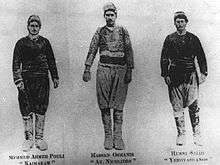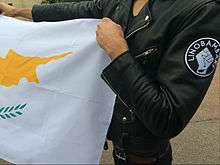Linobambaki
The Linobambaki or Linovamvaki were a Crypto-Christian Catholic community in Cyprus[1] who had been persecuted for their religion during Ottoman rule. They assimilated into the Turkish Cypriot community during British rule.[2][3]
Etymology
The word Linobambaki comes from Greek Λινοβάμβακοι, which derives from the combination of the words λινό (lino) "linen" and βαμβάκι (vamvaki) "cotton".[4] The term was used as a metaphor in order to demonstrate that even though they had Latin Catholic origins, they chose to appear outwardly Muslim.[5]
History

The Ottoman–Venetian War (1570–73) concluded with the remainder of Cyprus under Ottoman rule, and immediately after the war, sanctions were put in place for the Latin population of the island.[6] With Ottoman-Venetian rivalry at its peak, the Ottomans feared the security risk posed by the Latin Catholics of Cyprus, and in particular that they would entice the Venetians to return. As a result, Ottoman tolerance towards the Catholic community was much less than towards the Greek Orthodox community.[7] In addition to political and religious pressure, there was an economic oppression that included removing their rights to own property. The Catholic inhabitants affected by these acts consisted of Latins, Venetians, Genoeses, Maronites and Armenians who had converted to Islam in order to avoid slavery, oppression, or death and eventually derived the name of Linobambaki.[8]
The Linobambaki did not outwardly practice or demonstrate their religious beliefs, due to their faux conversion. Thus in their daily life, they chose to have either one Christian and one Muslim name, or a common name found in both faiths like Ibrahim (Abraham), Yusuf (Joseph) or Musa (Moses).[9] At annual conscription they were often drafted into the Ottoman army,[10] and they avoided paying taxes for non-Muslims. The Linobambaki did not entirely convert to a traditional Muslim life, and only demonstrated religious practices and beliefs that would gain them advantages only afforded to Muslims. For example, they frequently consumed alcohol and pork,[11] and didn’t attend religious services; traditions similar to continuing Turkish Cypriot culture today. Many of the Linobambaki villages have Christian saint names that begin with άγιος (ayios), or "saint" to attribute their Latin Catholic origins. Linobambaki’s cultural roots and history can be found throughout Turkish Cypriot life and literature. For example, two of the most prominent main characters from Cypriot folklore are "Gavur Imam" and "Hasan Bulli".[12] Linobambaki became a part of the majority of all uprisings and revolts against Ottoman rule, and other local government bodies on the island.[13]
Settlements
Many of the villages and neighbouring areas accepted as Turkish Cypriot estates, were formerly Linobambaki activity centers. These include:
- Agios Andronikos (Yeşilköy)[14]
- Agios Ioannis (Ayyanni)[15]
- Agios Sozomenos (Arpalık)[16]
- Agios Theodoros (Boğaziçi)[11][17]
- Armenochori (Esenköy)[18]
- Ayios Iakovos (Altınova)[18]
- Ayios Khariton (Ergenekon)[18]
- Dali (Dali)[16]
- Frodisia (Yağmuralan)[19]
- Galinoporni (Kaleburnu)[20]
- Kato Arodes (Aşağı Kalkanlı)[16]
- Tylliria (Dillirga)[21]
- Kornokipos (Görneç)[22]
- Kritou Marottou (Grit-Marut)[23]
- Limnitis (Yeşilırmak)[24]
- Louroujina (Akincilar)[25]
- Melounta (Mallıdağ)[18]
- Platani (Çınarlı)[22]
- Potamia (Bodamya)[16]
- Vretsia (Vretça)[15]
Today

The Ottoman Empire's millet system was abolished during British administration. In this period, the people of Cyprus were split into two main groups in censuses and administrative records.[26] Because of the polarization politics of the British administration, Linobambaki were integrated into the Turkish Cypriot community.[11] There were still Greek speaking settlements that identified themselves as Turkish Cypriots during the 1950s; settlements such as Lapithos, Platanissos, Agios Symeon and Galinoporni.[27]
There is currently a non-governmental organization called "LINOBAMBAKI" in Cyprus.[28]
See also
References
- ↑ Selim Deringil (2012). Conversion and Apostasy in the Late Ottoman Empire. Cambridge University Press. p. 112. ISBN 978-1-107-00455-9.
- ↑ Chrysostomos Pericleous (2009). Cyprus Referendum: A Divided Island and the Challenge of the Annan Plan. I.B.Tauris. p. 131. ISBN 978-0-85771-193-9.
- ↑ Hadjidemetriou (2010-03-23). "Οι κρυπτοχριστιανοί της Κύπρου". Church of Cyprus. Retrieved 10 May 2014.
- ↑ Pinar Senisik (2011). The Transformation of Ottoman Crete: Revolts, Politics and Identity in the Late Nineteenth Century. I.B.Tauris. p. 64. ISBN 978-0-85772-056-6.
- ↑ Idesbald Goddeeris (2004). De Europese periferie. Leuven University Press. p. 275. ISBN 978-90-5867-359-6.
- ↑ Servet Sami Dedeçay (2008). Kıbrıslı Türk kadınının eğitim aracılığı sayesinde dinsel mutaassıplıktan sıyrılıp çağdaş hak ve özgürlük kuralllarını kabullenişi. Lefkoşa Özel Türk Üniversitesi. p. 297.
- ↑ James Knowles (1908). The Twentieth Century and After. Spottiswoode. p. 753.
- ↑ Captain A. R. Savile (1878). Cyprus. H.M. Stationery Office. p. 130.
- ↑ Luigi Palma di Cesnola; Charles William King; Alexander Stuart Murray (1878). Cyprus: Its Ancient Cities, Tombs, and Temples : a Narrative of Researches and Excavations During Ten Years' Residence in that Island. Harper & Brothers. p. 185.
- ↑ Frederic Henry Fisher (1878). Cyprus, our new colony, and what we know about it. George Routledge and Sons. p. 42.
- 1 2 3 Tassos A. Mikropoulos (2008). "Linovamvaki". Elevating and Safeguarding Culture Using Tools of the Information Society: Dusty traces of the Muslim culture. Livanis. p. 93. ISBN 978-960-233-187-3.
- ↑ Erdönmez, Celâl (2004). "Linobambakiler". Şer'iyye Sicillere Göre Kıbrıs'ta Toplum Yapısı (1839-1856) (PDF) (Ph.D.). Süleyman Demirel Üniversitesi. p. 44. Retrieved 2014-06-10.
- ↑ Costas P. Kyrris (1984). Ανατομία του Οθωμανικού Καθεστώτος Στην Κύπρο 1570-1878. Nicosia: Dimos Lefkosias. pp. 64–66.
- ↑ Ian Robertson (1981). Cyprus. Benn. p. 85. ISBN 978-0-510-01633-3.
- 1 2 Marc Dubin (2002). Cyprus. Rough Guides. p. 412. ISBN 978-1-85828-863-5.
- 1 2 3 4 Jan Asmussen (2001). "Wir waren wie Brüder": Zusammenleben und Konfliktentstehung in ethnisch gemischten Dörfern auf Zypern. LIT Verlag Münster. pp. 78–79. ISBN 978-3-8258-5403-4.
- ↑ Tassos A. Mikropoulos (2008). "Linovamvaki". Elevating and Safeguarding Culture Using Tools of the Information Society: Dusty traces of the Muslim culture. Livanis. p. 93. ISBN 978-960-233-187-3.
- 1 2 3 4 Alexander-Michael Hadjilyra (2009). The Armenians of Cyprus. Kalaydjian Foundation. p. 13.
- ↑ Esat Mustafa (2013). Kıbrıs Tarihinde Yağmuralan (Vroişa) (in Turkish). Lefkoşa: Ateş Matbaacılık. p. 39.
- ↑ Bağışkan, Tuncer (2014-03-15). "Kaleburnu köyüne bir yolculuk (1)". YeniDüzen Gazetesi (in Turkish). Lefkoşa: United Media Group. Retrieved 2014-06-10.
- ↑ Kiamran Halil (1983). The Rape of Cyprus. Prosperity Publications. p. 19. ISBN 978-0-905506-07-4.
- 1 2 Louis Mas Latrie (1879). L'île de Chypre: sa situation présente et ses souvenirs du moyen-âge. Firmin-Didot et cio. p. 43.
- ↑ Tahsin, Arif Hasan (2004-09-03). "Yeter ki Tohum Çürük Olmasın". Yeniçağ Gazetesi (in Turkish). Lefkoşa. Retrieved 2014-06-10.
- ↑ Mahmut Islamoglu; Sevket Oznur (2013). Linobambaki: The Christian-Muslim Cypriots. p. 5.
- ↑ Samson Opondo; Michael J. Shapiro (2012). The New Violent Cartography: Geo-Analysis after the Aesthetic Turn. Routledge. p. 205. ISBN 978-1-136-34508-1.
- ↑ Beckingham, Charles Fraser (1957). "The Turks of Cyprus". Journal of the Anthropological Institute of Great Britain and Ireland. London: Royal Anthropological Institute. 87 (2): 170–171. ASIN B002HHIRQ8.
- ↑ Kagui, Olena (2015-04-03). "Patriots Punished in Northern Cyprus: A Modern Day Political Occupation". The Huffington Post. New York. Retrieved 2015-04-08.